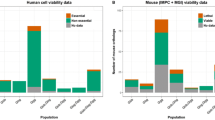Abstract
The chloride channel gene, CLCN4, has been previously mapped to the X chromosome in humans. We isolated a cDNA clone for mouse Clcn4 and used this to map the gene in an interspecific backcross. This revealed the surprising finding that the gene maps to the X chromosome in Mus spretus but to chromosome 7 in C57BL/6 mice. This is the first example of a gene that contravenes Ohno's law — it is a gene unique to the X chromosome in one eutherian species but autosomal in another. The consequence of this chromosomal rearrangement is that the gene is lost by mendelian segregation in a subset of the male progeny of a (C57BL/6 × Mus spretus) × Mus spretus backcross.
Similar content being viewed by others
References
Ohno, S. Sex chromosomes and sex linked genes. (Springer Verlag, Berlin, 1967).
Lyon, M.F. Gene action in the X chromosome of the mouse (Mus musculus L). Nature 190, 370–373 (1961).
Lyon, M.F. Some milestones in the history of X-chromosome inactivation. A. Rev. Genet. 26, 16–28 (1992).
Ellis, N. & Goodfellow, P.N. The mammalian pseudoautosomal region. Trends Genet. 5, 406–410 (1989).
Disteche, C.M. et al. The human pseudoautosomal GM-CSF receptor α subunit gene is autosomal in mouse. Nature Genet. 1, 333–336 (1992).
Miyajima, I. et al. The murine interleukin-3 receptor alpha subunit gene: chromosomal localization, genomic structure and promotor function. Blood 85, 1246–1253 (1995).
Herman, G.E., Boyd, Y., Chapman, V., Chatterjee, A. & Brown, S.D.M. Mouse X chromosome. Mamm. Genome 5, S276–S288 (1994).
Van Slegtenhorst, M.A. et al. A gene from the Xp22.3 region shares homology with voltage gated chloride channels. Hum. molec. Genet. 3, 547–552 (1994).
Koch, M.C. et al. The skeletal muscle chloride channel in dominant and recessive human myotonia. Science 257, 797–800 (1992).
Ptacek, L.J., Johnson, K.J. & Griggs, R.C. Genetics and physiology of the myotonte muscle disorders. New Engl. J. Med. 328, 482–489 (1993).
Caldwell, J.H. & Schaller, K.L. Opening the gates on ion channel diseases. Nature Genet. 2, 87–89 (1992).
George, A.L., Crackower, M.A., Abdalla, J.A., Hudson, A.J. & Ebers, G.C. Molecular basis of Thomson's disease (autosomal dominant myotonia congenita). Nature Genet. 3, 305–309 (1993).
Fisher, S.E. et al. Isolation and partial characterization of a chloride channel gene which is expressed in kidney and is a candidate for Dent's disease (an X-linked hereditary nephrolithiasis). Hum. molec. Genet. 3, 2053–2059 (1994).
Meindl, A. et al. Analysis of a terminal Xp22.3 deletion in a patient with six monogenic disorders: implications for the mapping of X linked ocular albinism. J. med. Genet. 30, 838–842 (1993).
The European Backcross Collaborative Group(1994). Towards high resolution maps of the mouse and human genomes — a facility for ordering markers to 0.1 cM resolution. Hum. molec. Genet. 3, 621–627.
Ashworth, A., Rastan, S., Lovell-Badge, R. & Kay, G. X-chromosome inactivation may explain the difference in viability of XO hurnans and mice. Nature 351, 406–408 (1991).
Salido, E.C. et al. Cloning of the mouse steroid sulfatase (Sts) gene. Am. J. hum. Genet. 55, A138 (1994).
Haldane, J.B.S. Sex ratio and unisexual sterility in hybrid animals. J. Genet. 12, 101–109 (1922).
Guenet, J.L., Nagamine, C., Simon-Chazottes, D., Montagutelli, X. & Bonhomme, F. Hst-3: an X-linked hybrid sterility gene. Genet. Res. 56, 163–165 (1990).
Biddle, F.G., Eales, B.A. & Dean, W.L. Haldane's rule and heterogametic female and male sterility in the mouse. Genome 37, 198–202 (1994).
Matsuda, Y., Hirobe, T. & Chapman, V.M. Genetic basis of X-Y chromosome dissociation and male sterility in interspecific hybrids. Proc. natn. Acad. Sci. U.S.A. 88, 4850–4854 (1991).
Hale, D.W., Washburn, L.L. & Eicher, E.M. Meiotic abnormalities in hybrid mice of the C57BI/6J × Mas spretus cross suggest a cytogenetic basis for Haldane's rule of hybrid sterility. Cytogenet. Cell Genet. 63, 221–234 (1993).
Coyne, J.A. The genetic basis of Haldane's rule. Nature 314, 736–738 (1985).
Church, G. & Gilbert, W. Genomic Sequencing. Proc. natn. Acad. Sci U.S.A. 81, 1991–1995 (1984).
Willison, K.R., Dudley, K. & Potter, J. Molecular cloning and sequence analysis of a haploid expressed gene encoding t complex polypeptide 1. Cell 44, 727–738 (1986).
Author information
Authors and Affiliations
Rights and permissions
About this article
Cite this article
Palmer, S., Perry, J. & Ashworth, A. A contravention of Ohno's law in mice. Nat Genet 10, 472–476 (1995). https://doi.org/10.1038/ng0895-472
Received:
Accepted:
Issue Date:
DOI: https://doi.org/10.1038/ng0895-472
- Springer Nature America, Inc.
This article is cited by
-
Functional and clinical studies reveal pathophysiological complexity of CLCN4-related neurodevelopmental condition
Molecular Psychiatry (2023)
-
A pronounced evolutionary shift of the pseudoautosomal region boundary in house mice
Mammalian Genome (2012)
-
Breaking laws and obeying rules
Nature Genetics (1996)
-
Reply to “Breaking laws and obeying rules”
Nature Genetics (1996)
-
The DAZ gene cluster on the human Y chromosome arose from an autosomal gene that was transposed, repeatedly amplified and pruned
Nature Genetics (1996)





